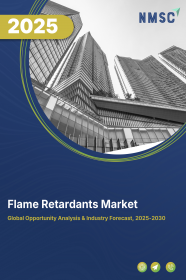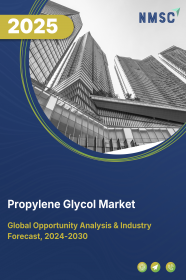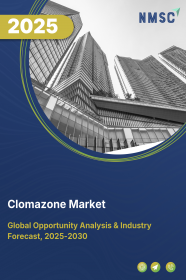
Flame Retardants Market by Type (Alumina Trihydrate, Brominated Flame Retardants, Antimony Trioxide, Phosphorous Flame Retardants, and Others), by Application (Unsaturated Polyester Resins, Epoxy Resins, PVC, Rubber, Polyolefins, and Others), and by End User Industry (Construction, Automotive, Transportation, Electronics, Textile, and Others)– Global Opportunity Analysis and Industry Forecast, 2025-2030
Industry: Materials and Chemical | Publish Date: 05-Feb-2025 | No of Pages: 445 | No. of Tables: 275 | No. of Figures: 220 | Format: PDF | Report Code : MC60
US Tariff Impact on Flame Retardants Market
Trump Tariffs Are Reshaping Global Business
Flame Retardants Market Overview
The Flame Retardants market size was valued at USD 9.07 billion in 2024, and is predicted to reach USD 13.15 billion by 2030, with a CAGR of 6.4% from 2025 to 2030.
The flame retardants market is driven by factors such as growing demand for safety in electric vehicles, stringent government regulations, and global shift towards environmental sustainability.
However, the market faces challenges due to reliance on harmful chemicals such as halogenated compounds. On the other hand, the use of nanoparticles as flame retardants in unsaturated polyester resins holds great future prospects.
Moreover, the major market players of the market such as Albemarle Corporation, BASF SE, The Dow Chemical Company (DOW), and others are using various developmental strategies to sustain their position in the market.
Growth In Demand for Vehicle Safety Fuels the Flame Retardants Market Growth
The flame-retardant market is driven by the growing demand for safety in electric vehicles as these materials are in use to increase the safety level of the batteries and reduce thermal runaway incidents.
In September 2024, Asahi Kasei unveiled LASTAN, a flame-retardant nonwoven fabric to be used in improving the safety of electric vehicle batteries. The newly developed material resists burning up to 1,300°C and offers electrical insulation at up to 3.5 kV, so that it can serve a wide field of applications with batteries.
With growing market development, there is an increasing requirement toward advanced fire-resistant solutions to meet the evolving needs and maintain efficiency and safety across the industry.
Stringent Government Regulations are Boosting the Flame Retardants Market Demand
The demand for flame-retardant materials increased on account of increasingly higher regulatory demands within diversified industries such as construction, electronics, and automotive. Various measures have been adopted by different countries toward fire safety, implying thereby that the use of flame retardants is compelled.
The US Environmental Protection Agency, in September 2023, finalized its risk evaluation for Tris(2-chloroethyl) phosphate-or TCEP for short-pushing the urgency for innovation by manufacturers to come up with flame retardant products that are safer.
Similarly, in October 2024, the UK government issued new proposals that would incentivize the use of inherently flame-retardant materials and the design of products that require less chemical addition. These set the trends that reinforce commitments to enhanced safety and sustainability across industries and are forcing manufacturers to invest in newer flame-retardant technologies.
Environmental Sustainability Drives Demand for Eco-Friendly Flame Retardants
Consumer demand for environmentally safe flame retardants emerged due to rising environmental awareness, thereby transforming the flame-retardant industry.
In June 2023 Avient Corporation released sustainable flame-retardant thermoplastic elastomer (TPE) grades under a new lineup destined for USB-C cable jacket applications. As consumer electronics required environmentally sustainable materials the product delivered compliant fire safety while addressing rising industry demand for eco-friendly products.
Reliance on Harmful Chemicals Acts as a Restraint in the Flame Retardants Market
Harmful chemicals particularly including halogenated compounds act as the biggest restriction in the flame retardants market expansion as numerous health dangers, toxin production, and lasting environmental damage are connected to these substances.
Protective regulatory body forces enacted tougher security guidelines after recognizing ongoing adverse effects and restricted these materials from further application. Manufacturers faced hurdles as they need to develop sustainable flame treatments while grappling with higher costs and lower efficiency than traditional fire retardants.
Incorporating of Nanoparticles in UPRs Creates Future Opportunities
The use of nanoparticles as flame retardants in unsaturated polyester resins (UPRs) offers promising future opportunities in the flame retardants market. Nanoparticles significantly enhance the thermal stability and reduce the flammability of UPRs, addressing the limitations of traditional flame retardants, that often compromise mechanical properties and pose environmental risks.
Market Segmentation and Scope
The flame retardants market report is segmented on the basis of type, application, end-user, and region. On the basis of type the market is segmented into alumina trihydrate, brominated flame retardants, antimony trioxide, phosphorous flame retardants, and others. Based on application the market is divided into unsaturated polyester resins, epoxy resins, pvc, rubber, polyolefins, and others. Based on end-user the market is segmented into, construction, automotive, transportation, electronics, textile, and others. The regional breakdown includes region such as North America, Europe, Asia-Pacific and, Rest of the Word (RoW).
Regional Analysis
Asia-Pacific Dominates the Flame Retardants Market Share
The growing automotive sector throughout Asia Pacific requires flame retardants as primary solutions for boosting vehicle fire safety by minimizing ignition risks and flame propagation during emergencies. The International Trade Administration determines that China leads both the automotive production and sales figures maintaining its spot as the world's largest vehicle market.
For 2025 domestic automotive production estimates predict 35 million manufactured vehicles that demonstrates the nation's dominant position and increasing automotive market share. With such growth in automotives there is rising demand for advance fire resisting solutions to ensure safety standards and regulations compliance.
Also, the growth of electronic devices along with gadgets throughout the region enhanced the need for components containing flame retardants for safety against product fires. GSMA projects Asia Pacific will have more than 3 billion smartphone connections by 2030 and the regional smartphone adoption rate will be 94% while the global average stands at 92%. The expanding requirement for flame retardant materials within the electronics manufacturing sector throughout different industries generates ongoing demand for flame retardants within the Asia Pacific markets.
North America to Show Steady Growth in the Flame Retardants Industry
North America is showing steady rise due to strict regulations and standards initiated by government bodies and industry associations to create better fire safety in various sectors such as electronics and automotive. The US government introduced the "Significant New Uses Rules for Certain Non-Ongoing Uses" on June 22, 2023, through the Environmental Protection Agency (EPA).
It requires notice to the EPA before chemical substances and mixtures are used in new ways, with a requirement for notification at least 90 days prior to initiating activities via a significant new use notice (SNUN). These regulations mandate the use of flame-retardant materials in building materials, electronic devices, and vehicles to mitigate fire risks and ensure compliance with safety requirements.
Additionally, the developed transportation sector in the region is also advancing the flame retardants market trends in the country as it has higher safety standards. According to American Trucking Association, trucks accounted for 72.6 percent of the U.S. freight tons in 2022 and 11.46 billion tons freight was moved over roads by the trucks in that year.
Advanced automotive technologies, the integration of as many electronic items as possible inside vehicles, tend to increase incidents related to a fire and accordingly, raise their demand for developing sophisticated solutions of preventing these possibilities.
Competitive Landscape
Several key players operating in the flame retardants industry include Albemarle Corporation, BASF SE, The Dow Chemical Company (DOW), Eastman Chemical Company, Laxness AG, Italmatch Chemicals S.p.A, Clariant, Nabaltec AG, NYACOL, DIC Corporation, Thor, DAIHACHI Chemical, Huber Engineered Materials, ICL Group, and others.
These market players are adopting product launches across various regions to maintain dominance in the flame retardants industry.
For example, in December 2024, ICL introduced VeriQuel R100 a ground-breaking reactive phosphorus flame retardant specifically designed for rigid polyurethane insulation products. The new inventive chemical bonding technology secures both environmental law compliance and production process compatibility together with extended material performance duration.
For instance, in May 2023, Huntsman Corporation recently developed new materials designed to be more flame-retardant in consumer electronics. Such materials advance fire safety in smartphones, tablets, and laptops.
Flame Retardant Market Key Segments
By Type
-
Alumina Trihydrate
-
Brominated Flame Retardants
-
Antimony Trioxide
-
Phosphorous Flame Retardants
-
Others
By Application
-
Unsaturated Polyester Resins
-
Epoxy Resins
-
PVC
-
Rubber
-
Polyolefins
-
Others
By End User Industry
-
Construction
-
Automotive
-
Transportation
-
Electronics
-
Textile
-
Others
By Region
-
North America
-
The U.S.
-
Canada
-
Mexico
-
-
Europe
-
The U.K.
-
Germany
-
France
-
Italy
-
Spain
-
Denmark
-
Netherlands
-
Finland
-
Sweden
-
Norway
-
Russia
-
Rest of Europe
-
-
Asia-Pacific
-
China
-
Japan
-
India
-
South Korea
-
Australia
-
Indonesia
-
Singapore
-
Taiwan
-
Thailand
-
Rest of Asia-Pacific
-
-
Rest of the World (RoW)
-
Latin America
-
Middle East
-
Africa
-
Key Players
-
Albemarle Corporation
-
BASF SE
-
The Dow Chemical Company (DOW)
-
Eastman Chemical Company
-
Laxness AG
-
Italmatch Chemicals S.p. A
-
Clariant
-
Albemarle Corporation
-
Nabaltec AG
-
NYACOL
-
DIC Corporation
-
Thor
-
DAIHACHI Chemical
-
Huber Engineered Materials
-
ICL Group
REPORT SCOPE AND SEGMENTATION:
|
Parameters |
Details |
|
Market Size in 2024 |
USD 9.07 Billion |
|
Revenue Forecast in 2030 |
USD 13.15 Billion |
|
Growth Rate |
CAGR of 6.4% from 2025 to 2030 |
|
Analysis Period |
2024–2030 |
|
Base Year Considered |
2024 |
|
Forecast Period |
2025-2030 |
|
Market Size Estimation |
Billion (USD) |
|
Growth Factors |
|
|
Countries Covered |
28 |
|
Companies Profiled |
15 |
|
Market Share |
Available for 10 companies |
|
Customization Scope |
Free customization (equivalent up to 80 working hours of analysts) after purchase. Addition or alteration to country, regional, and segment scope. |
|
Pricing and Purchase Options |
Avail customized purchase options to meet your exact research needs. |

















 Speak to Our Analyst
Speak to Our Analyst





















